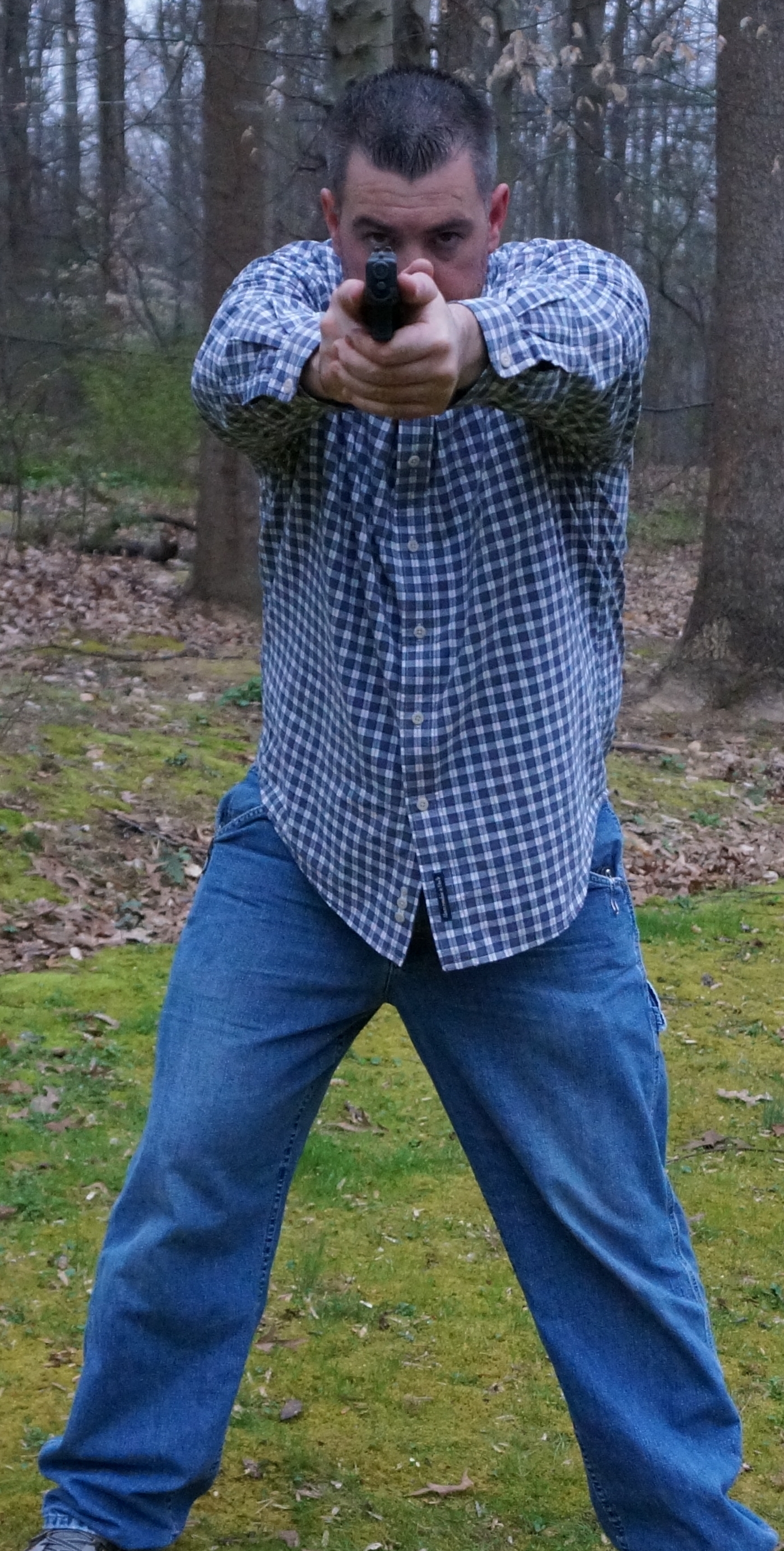
Magazine is now empty, slide has locked back, and author has recognized that slide has locked to the rear through stimulus.
In addition to what the title suggests, this article will also cover the reasons you shouldn’t look at your gun while working on it, period. This includes loading, unloading, and clearing malfunctions. Though this is a highly debated and emotional topic on social media and the internet, most progressive trainers agree that if you are training for personal defense, looking at the gun to complete complex motor functions is not a good idea.
CONTEXT
To view this topic with reason and logic, first we must cover the contexts we are training for in regard to personal defense. Not all law-abiding citizens have the same context. But, even over the probable or likely scenarios we could find ourselves immersed in, the importance of not relying on visual data to complete complex motor functions is still significant.
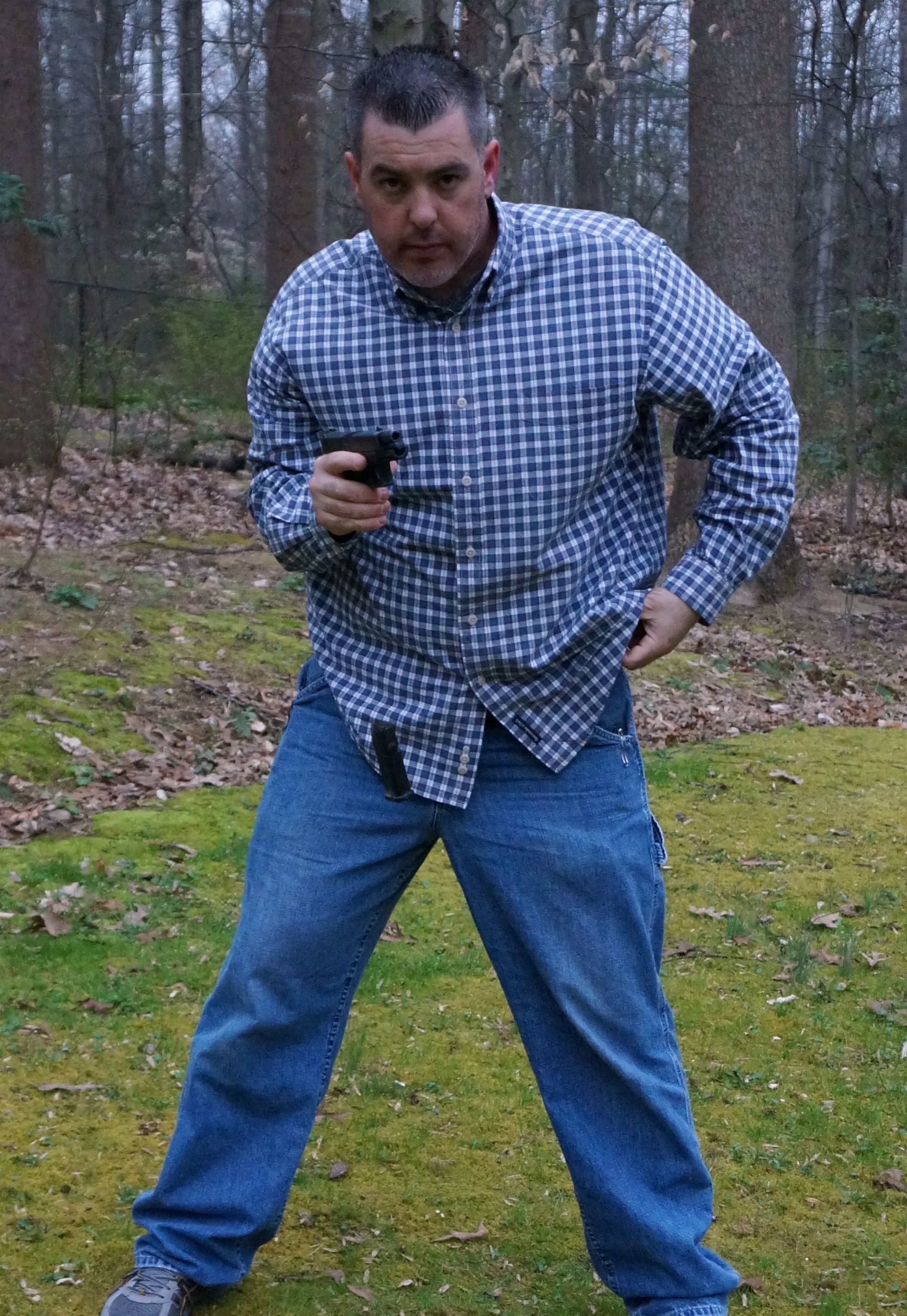
Author responds to stimulus of slide locking to the rear and has simultaneously brought gun back into high compressed work area, ejected magazine, and is reaching for a full magazine carried horizontally on his belt.
The context of a match or course of fire that is being scored (including but not limited to qualification shoots), is to win, be safe, shoot straight, get quality hits with the least amount of deviation, and do this as fast as you can. As a past competition shooter and member of USPSA, GSSF, and IDPA, I understand the allure of matches. You get to hang out with friends and likeminded folks and shoot firearms. What’s not to like? Just because it “works in competition or qualifications” does not mean those techniques are the best for real life-or-death scenarios, which are often ambushes, in the public space.
Life-or-death scenarios involve natural reactions that are rarely realized by the person perceiving the threat, and in many cases are not even observed by onlookers, at least the external natural reactions. This is why the skills that will place you at the top of competition matches and qualifications are, most of the time, not the same that will help you stop a threat in real life. If you are worried about shaving .10 or .25 second off your reload time to help better your score, that’s great, it’s just not the goal (or shouldn’t be your goal) if you are training as a law-abiding citizen to stop a threat efficiently.
EFFICIENCY
Your goal should be to learn skills that are efficient in the context you are training for. Efficiency is probably the most poorly defined term when it comes to personal defense, largely because of the competition industry, which heavily affects the way people train and think about training. Law enforcement and military/security contractor-type training, which also focuses on different contexts than your average law-abiding citizen, has affected the private-sector training industry immensely. I define efficiency as “in as little time and with as little effort and energy needed to complete the task in the correct context.” “Context” is probably the most forgotten and vital piece of information when it comes to firearm training, specifically, personal defense training.
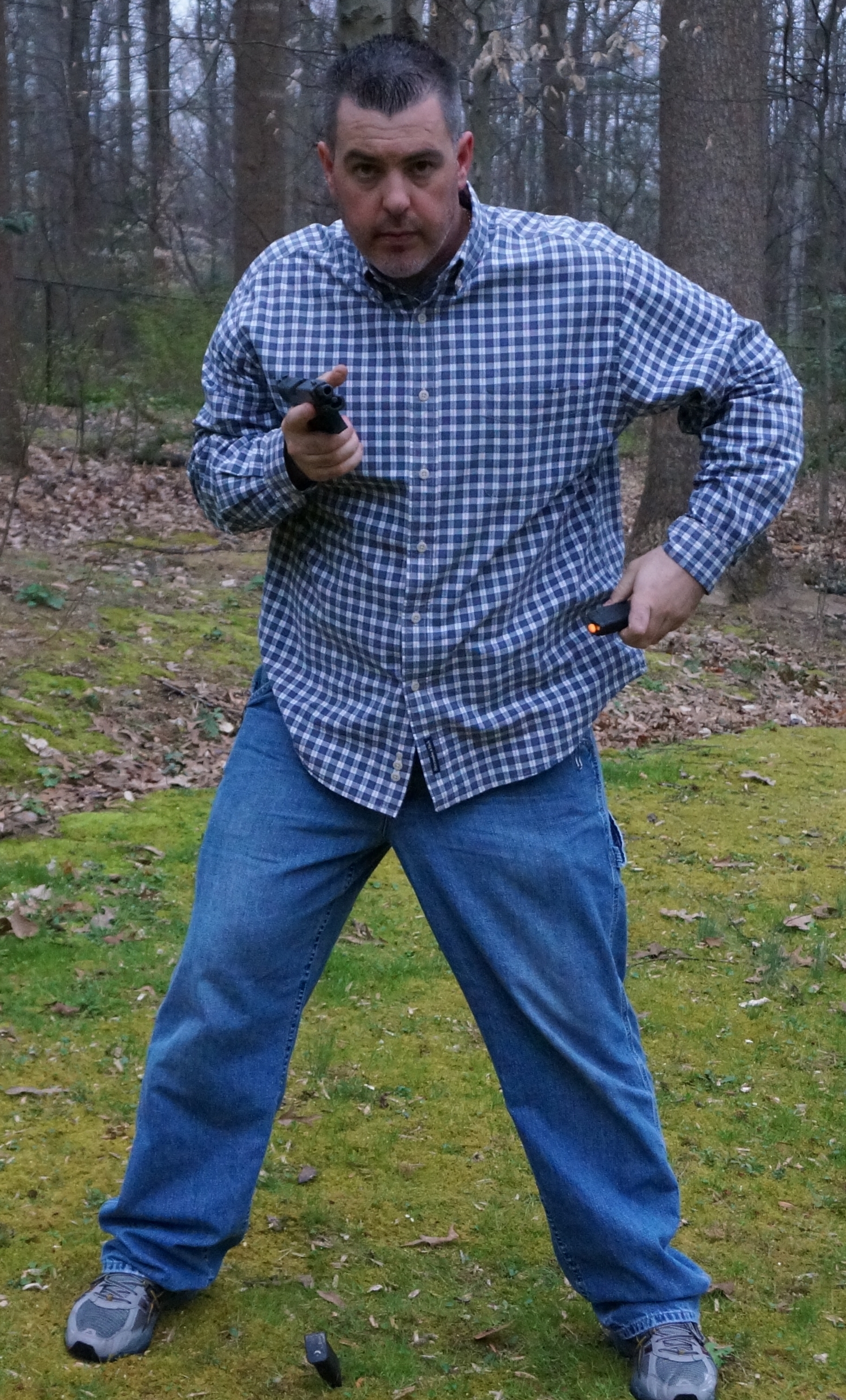
Author continues to look in direction from which threat was initiated. He does not rely on visual data to complete complex motor functions.
There are exceptions to these contexts that you should train for. Instructors should avoid absolutes: you could help your students form the wrong opinions or ignore the need for training for something that is possible, although not likely. Having said that, it is our job to help our students learn how to train more efficiently, but having them stand at the 25-yard line and take head shots for 45 minutes out of the hour is ridiculous when it is much more likely they will need skills in the seven- to 15-foot range. I tell my students to look at the statistics for defensive gun use (DGU). This statistical data should help you form a solid training plan.
I am not saying you shouldn’t practice 25-yard precision shots. I am saying that if about 80% of all DGUs are near the 12-foot range, that is what you want to spend a majority of your time training for. Spend more time training for things that are likely to occur and less time training for things that are less likely to occur. If you are interested in this perspective, search for articles relating to the “plausibility principle.” Having said all of this, whether you are at zero or 50 feet from an adversary when you need to do a reload or clear a malfunction, there are concrete and vital reasons you should not be looking at your gun while working on it.
WHERE SHOULD WE WORK ON THE GUN?
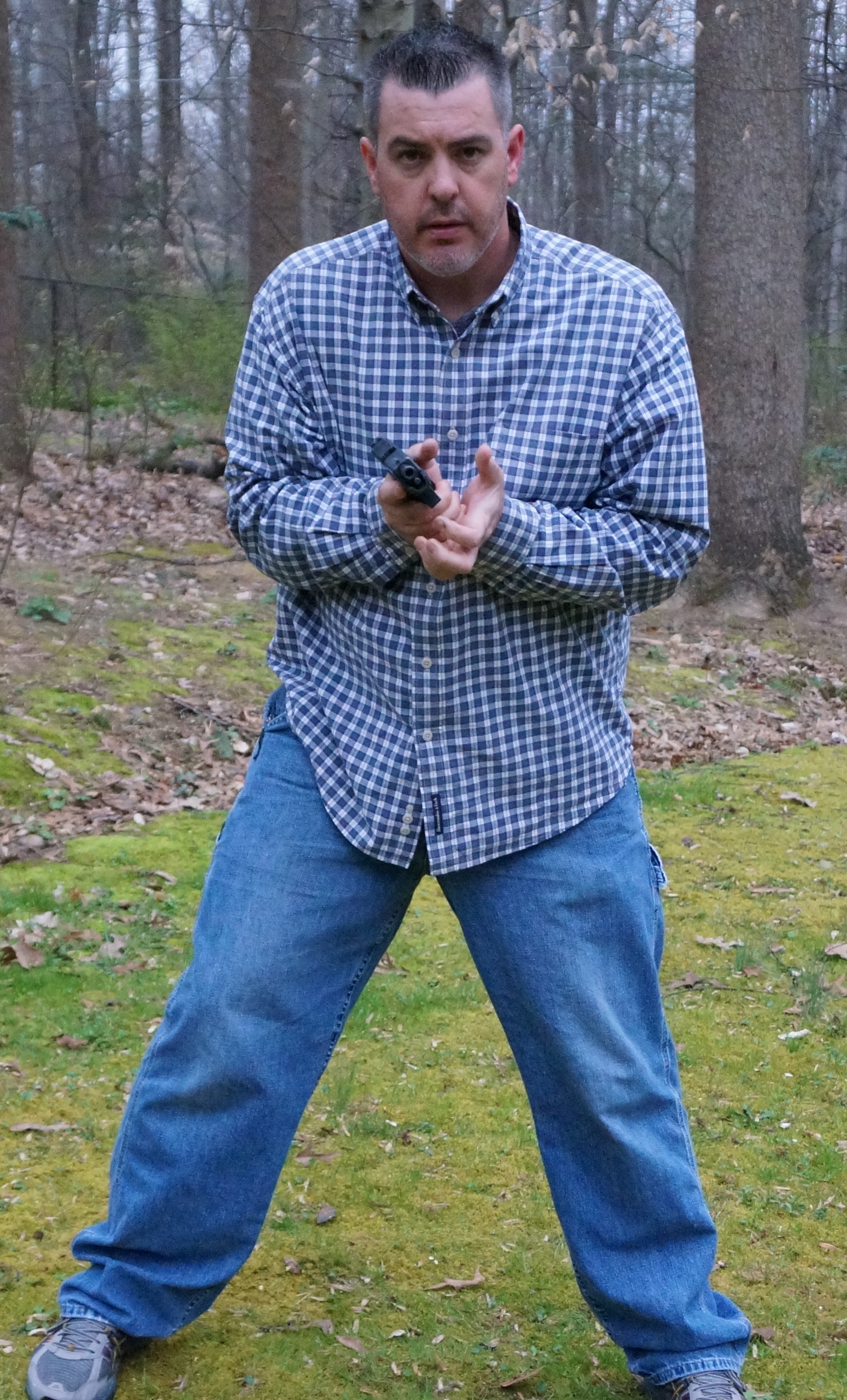
He continues to process new information while working on getting the fresh magazine into the gun, chambered and back into battery.
Although this is covered in other articles I have written, I will touch on it again because it relates to this topic. The answer is, “in your high compressed ready position.” Where is this? It is in front of your chest, around the sternum, with the firearm parallel with your line of sight but not in your line of sight, and elbows at your sides. You should also have a proper grip on the gun, whether that be with one or both hands. You do this because it is a strong, ergonomic position that allows you to work on the gun with higher dexterity, strength, and retention when needed. The gun is also close to your chest, hence the name high “compressed” ready position. I like to think of this as the default position when not in the holster but also not shooting. You could be scanning for a potential threat after engaging and stopping the first, reloading, loading the gun, or possibly clearing a malfunction. Think about where humans are most efficient at working on things. If I were struggling to get the top off a jar of mayonnaise and I handed it to you, where would you place that jar to attempt removing the top?
Another reason to mention the high compressed ready position is because by having the gun in this position, it also leaves your field of view clear so you can take in new information, what many others and I like to call processing information. The more information and stimuli you can gather for your brain to process in your environment, the better your brain can filter this information accurately in order to produce learned and/or stimulus responses. For those who don’t train frequently and realistically enough, at least it will help you decide and act on better and more complete information in your environment.
TUNNEL VISION
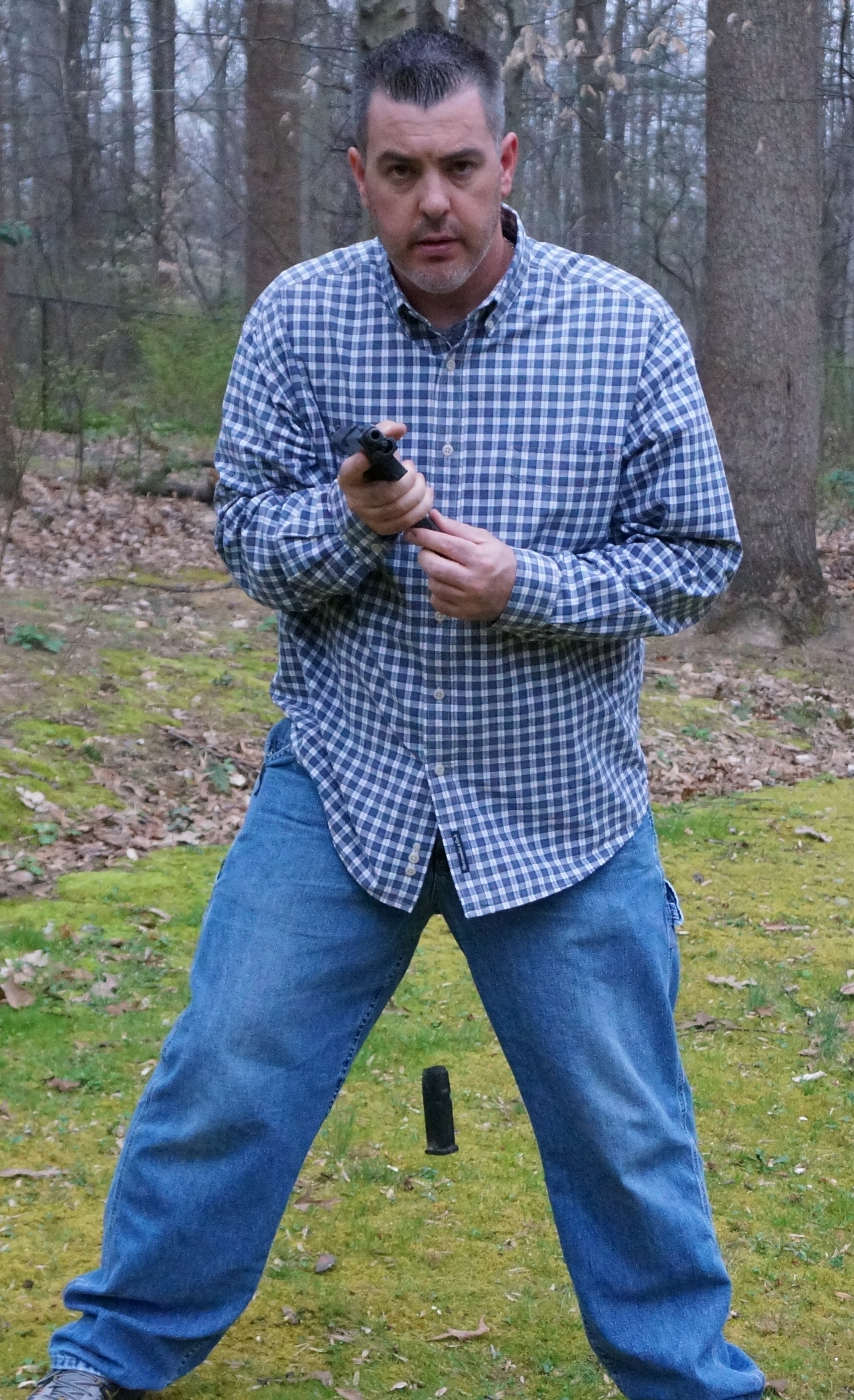
Author inserts full magazine into the mag well of a modern striker-fired handgun, while also keeping it in an efficient and consistent high compressed ready position.
Now that we have some foundation, let’s discuss why we shouldn’t look at the gun while working on it. In severe stress situations, especially those involving life and death during violent encounters, there is a tendency to have a threat focus, more accurately described as having a rise of visual acuity in the center of your field of vision. This is colloquially known as “tunnel vision,” which puts a negative connotation on what is really happening and also is not accurate in defining what and why this is happening. In relation to vision and this rise of visual acuity, here are a few points to consider.
1. You may not be able to break that focus on the threat to do a reload in the middle of an attack.
a. Why spend time training to look at your gun while reloading when it is highly unlikely that you will be able to anyway? This is why context is so important. I understand this is not happening on the range while practicing, but if you understand the context you should be training for, you will understand that this is likely to occur in real life.
b. If you know this, why would you continue to train in a way that is not congruent with what actually happens to the human body in real life?
2. Even if you could break that focus, you shouldn’t be looking away from the danger area until you have determined that the threat(s) are over.
a. And even if you could, would you want to? Wouldn’t it be better to keep processing the area while you are completing the reload? I think so. You could be scanning your area for new information to help you make better decisions, e.g, Where to move to? Is there cover or concealment? Are there more bad guys? Are police arriving? Was anybody besides the bad guys injured? Where is your family?
3. If you are attacked in a low- or no-light situation and need to work on the gun, you may not be able to see it because of the limited lighting. Being able to work on the gun without the visual information may prove essential.
4. In an entangled fight where a gun is present and needs to be reloaded or cleared of a malfunction, you may not be able to see the gun.
TIME DISTORTION AND TASK FIXATION
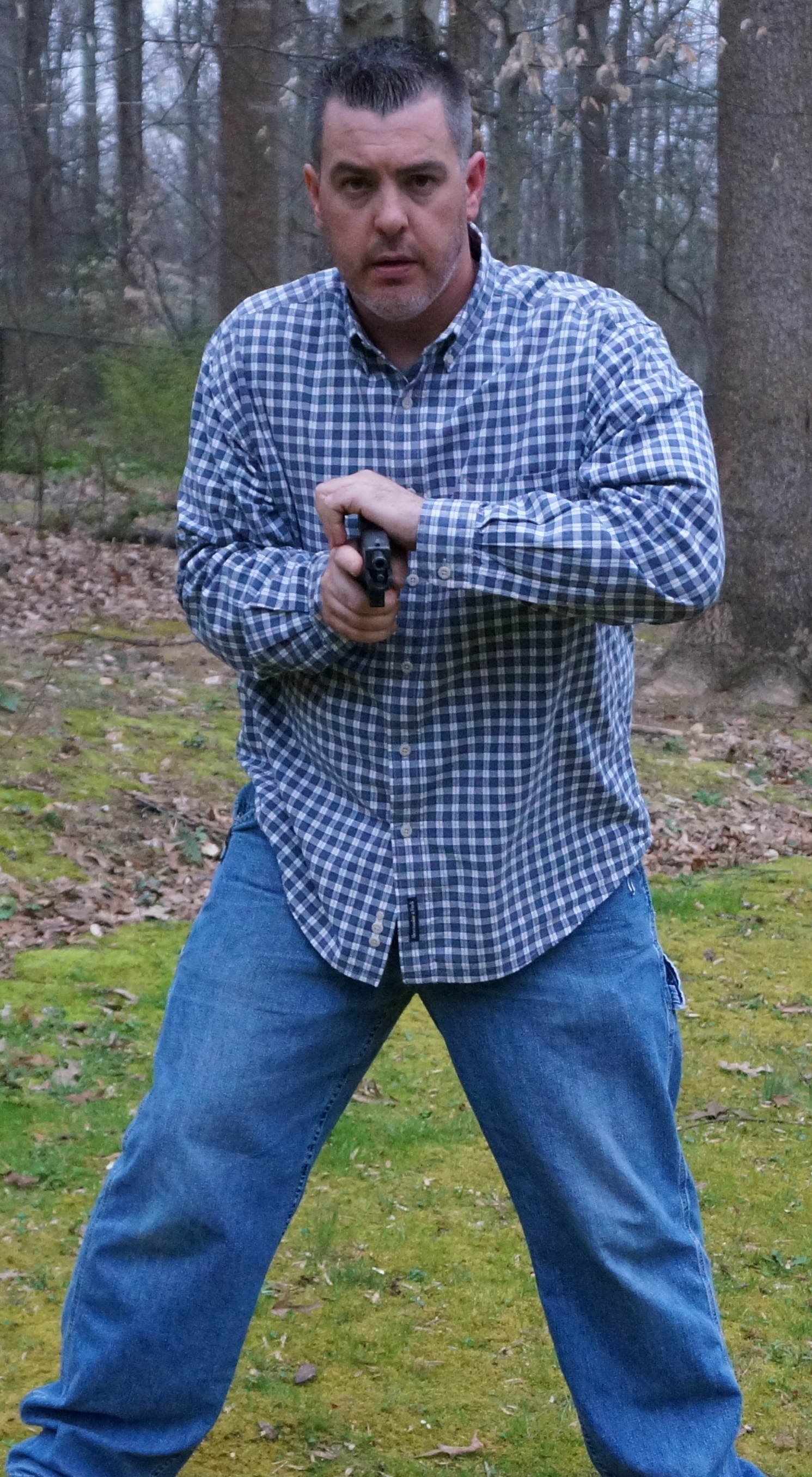
Author followed magazine up and firmly inserted it in the mag well. He has now rotated his hand up and over the slide (behind the ejection port) and has grabbed on to the slide serrations to rack the slide to the rear and chamber a round.
Under this type of stress, other things are happening internally to your body. In this case it relates directly to the rise of visual acuity in the center of your field of vision, which means you are able to take in more information about the threat. The problem is you cannot process that information any faster, causing what is called a “time distortion,” where things appear to be in slow motion. In reality it’s just your perception. Time is not actually slowing down. You have most likely not been in a shooting, but almost all adults have experienced time distortion.
Think back to when while driving, you almost hit a deer or almost ran into someone who jumped out in front of you. Close your eyes and recall that incident. You probably have very vivid recollections of it and can remember feeling like things were moving in slow motion. Now imagine you are in the middle of a critical incident and are able to break that threat focus (albeit unlikely) and you look down at your gun to do the reload and it appears you are moving in slow motion. What are you likely to do? Speed up because you think you are moving too slowly, then you will likely mess up the reload, which now could take even more time, meaning more time exposed to the threat and less time processing information in your environment.
Task fixation is another possible byproduct of looking at your gun. You can watch numerous videos online that drive home this point. I have been in force-on-force classes where a bad-guy role player was attacking a good-guy role player and, when the good guy drew his (sim) gun and pulled the trigger, it went “click,” and most of his focus went from the attack and controlling the adversary to trying to get the gun up and running. During that time, the good guy received what could have been fatal blows and was taken to the ground almost every time, which ended up in a fight for the gun because the good guy relinquished control and traded it for trying to clear and reload the gun (i.e., he was fixated with a task).
MALFUNCTIONS
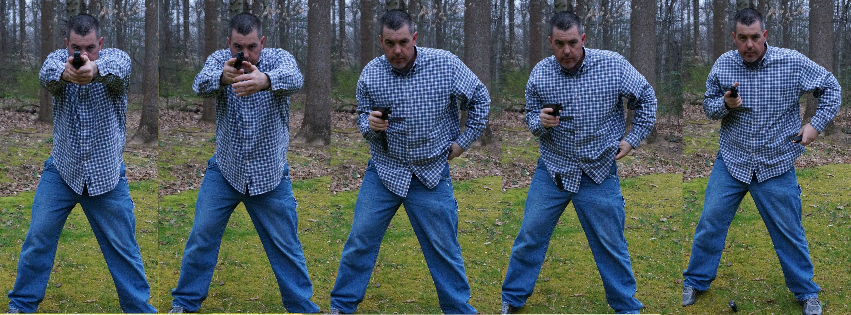
Time lapse, starting with recognition of slide lock due to magazine being dry and out of ammunition.
If you encounter a malfunction while shooting, do not try to diagnose the issue. You can also use the “plausibility principle” in this approach. Rather than looking at the gun, you can follow a linear set of steps to work on it based on the likelihood that it will clear or help you get your gun back up and running so you can stay in the fight and prevail. This is called Non-Diagnostic Linear Malfunction Clearing. The steps in this procedure are:
1.Tap the magazine with your support-hand palm.
2.Overhand rack the slide all the way to the rear and then let it go. (This will clear 85 to 95% of malfunctions that you could experience when using quality firearms and ammunition.)
3.If the above steps don’t clear the issue, and you should know by the stimulus or feedback you get from the gun, go into a reload. (This will clear about 3 or 4 of the remaining percentage points.)
4.Strip/rip, lock or remove the magazine, clear x3, then do a reload. (This will clear the remaining 1 to 2% of malfunctions.)
Having a non-diagnostic linear clearing method in your arsenal is very important. It also allows you to de-select yourself from some of the negative things we have already discussed in detail, like task fixation.
Whether you are loading your gun before you leave your house and putting it in your concealed carry holster or unloading it when you come home for safe storage, keep the gun in the high compressed ready position with the proper grip … and don’t look at the gun.
Practice efficiently and consistently. A key to developing this skill is having the gun in the correct position in front of your chest. Proprioception and ergonomics help you to interact with your defensive tool much more efficiently and easily. Now it’s time for you to head to the range and start practicing these skills. It may feel slow at first if you have never done it, but just like any other shooting or personal-defense skill you’ve had to learn, you can’t just snap your fingers and you’ve mastered it. You have to slow down, internalize what you’re doing, practice it frequently, and keep developing and evaluating your skills.
Stay safe and I hope to see you out on the range. Train smart, train hard, train realistically!
All pictures were taken with an NEX-5R and a remote capture phone application through an iPhone. The remote was controlled by Laura Carson.
I have to disagree with much of this article. IDEALLY, manipulation of the weapon would be “eyes-free.” However, real life intrudes. Discounting the human reaction to threat and the overpowering need to see what is most important in this moment creates unrealistic expectations, at best. "Tunnel vision" is a natural survival response, intensely focusing us on what is most threatening. "Breaking tunnel vision" is a false concept. If your attentional focus is now on fixing your weapon (reload/malfunction), tunnel vision is broken and not a factor (that doesn't mean the individual is no longer overwhelmed in problem-solving, just that the vision quickly returns to normal). Under threat/pressure, we necessarily focus on what is most important to us NOW. If our weapon isn't working, we focus on that if the threat is not close or more overwhelming than the need to solve our weapon's problem (meaning we aren't able at that moment shift attention to the weapon, e.g., the example the author gave of students continuing to press the trigger on an empty weapon while being killed). Our vision is what we most rely upon when under threat. The question should be, "How do I fix my weapon problems while maintaining my situational awareness?" Keeping our heads up while bringing our weapon up into our eye-target-line (or eye-threat-line) allows us to observe the threat while quickly transitioning to assessing the problem and then quickly returning to observing threat. Much during a reload or stoppage drill can be accomplished without looking at the weapon, e.g., drawing a new mag while dropping the empty mag. And while some highly trained individuals with extensive combat experience may be able to perform under existential threat without looking at their weapon, we see almost everyone else in that situation look at their weapon while problem-solving. By bringing the weapon into our field of vision (our "work space"), it permits our eyes to rapidly move to and from the weapon as needed. The key to remaining combative and effective during reloads and stoppage responses is to keep our heads up. Burying our head by looking down takes us out of the fight and requires us to reorient to the threat. The time it takes our eyes to flit from the threat to the mag well or ejection port and flit back to the threat is not likely to determine our survival. Putting the weapon to one's chest and then problem-solving will inevitably cause the individual to look down, completely losing situational awareness and location of the threat. Games are generally won and lost with the tenths of a second gained or lost by reloads. Gunfights are generally won by early recognition of threat indicators, decisiveness, accuracy, and, unfortunately, luck. It’s OK to look at your weapon while problem-solving. Just keep your head up and in the fight while doing so.
IF you have a Class 3 malfunction and DON'T look into the gun for any brass before you hit the mag release button, you are going to be in a world of hurt when you bring the fresh mag up with your support hand and the mag in the gun is jammed tight. And it could also be an empty mag in the gun, slide lock and the mag doesn't drop free. I train the military. Their weapons get pretty dirty. We head to the range with a nice clean well lubricated weapon. 2 different worlds. I believe this treatise can get you killed in a gunfight.
Lots of interesting views from many different people, I would wonder how many have ever been in an actual shoot out situation. The best way is the way you are most comfortable at but nothing is any good without hours of practice so that it becomes second nature when you have to do it.
Unless it is an emergency reload (empty mag), I recommend you check your magazine carrier to be sure you have a spare there before you hit the release button and let the active mag fall to the ground. You just might need to retain it if there are rounds in it.
EXCELENTE EL ARTICULO. FELICITACIONES. DESDE HACE UN TIEMPO HE TRATADO DE UNIRME A PDN SIN LOGRARLO, SOY VENEZOLANO PERO VIVO ACTUALMENTE EN MEXICO MI TELEFONO AQUI ES 9933782646, NO TENGO LOS MEDIOS PARA HACER EL PAGO. FUI TIRADOR IPSC CATEGORIA MASTER, E INSTRUCTOR AVANZADO DE LA ANTIGUA ACADEMIA DE RAY CHAPMAN EN DEFENSA PERSONAL. SI USTEDES TIENEN UNA FORMULA PARA YO PODER PAGAR MI MEMBRECIA EN UNA ENTIDAD BANCARIA O FINANCIERA LO HAGO CON EL MAYOR PLACER. GRACIAS DE ANTEMANO POR LA ATENCION QUE SABRAN DISPENSARLE A ESTA NOTA .
Nuthin' like small, thin-lined, light grey print to make reading enjoyable.
Very interesting about time distortion. I learned why after many years time seemed to slow down and worse, why I made things worse during some of those times where time seemed to be distorted. Your explanation was like a paradigm shift. I had read about this but your explanation finally made it click.
Combat or Tactical reload?: Combat: You never drop your pistol out of view. You bring it back at eye level or a little lower as not obstruct your view, and rotate it so your shooting arm is in a natural position of rest,release and strip mag in one movement, slam new mag in and do not rely on the slide release, come over the top like you would in a failure drill and "rack" like you would in a "tap" "rack" "bang" scenario. Then go back to work. Tactical reload: Leave the firearm in a state of ready with your arms extended, bring your weak hand off and locate your new mag. (This takes practice) hold the new mag in your hand/fingers gripped to the outside. Release and remove the old mag and take it out in the palm of your hand and rotate your hand so the new mag is in position and insert into the mag well. Place new mag in back pocket or another location that is easily gotten to, but NOT next to your other spare mag, lest you need to combat reload and get the one low on ammo. All this is done at eye level so you can view with your peripheral vision while scanning for threats. Tactical reloads can be done from the last position you fired from as the idea is the threat is down. Combat reloads are active and fluid and you should seek cover/concealment. DO NOT BRING THE FIREARM LOWER THAN YOUR EYE LEVEL OR TO YOUR ABDOMEN TO RELOAD. Also remember, finger off the trigger people.
That is a very good article and you presented it well. I do not have a problem with any part of the article. Thank you. I suggest that practice and more practice is very important.
Excellent piece. It's exactly how I was trained when we transitioned from revolvers to semi-automatic pistols. Tap, rack, bang... while ALWAYS keeping your eyes on the threat and scanning for other threats.